Talgo Bundle
How has the Talgo Company revolutionized rail travel?
The Talgo SWOT Analysis reveals a company with a rich history, a Spanish train manufacturer that has significantly impacted the railway industry. From its inception, Talgo has been at the forefront of innovation, particularly with its unique articulated suspension system. This design allows Talgo trains to navigate curves at higher speeds, enhancing both efficiency and passenger experience.
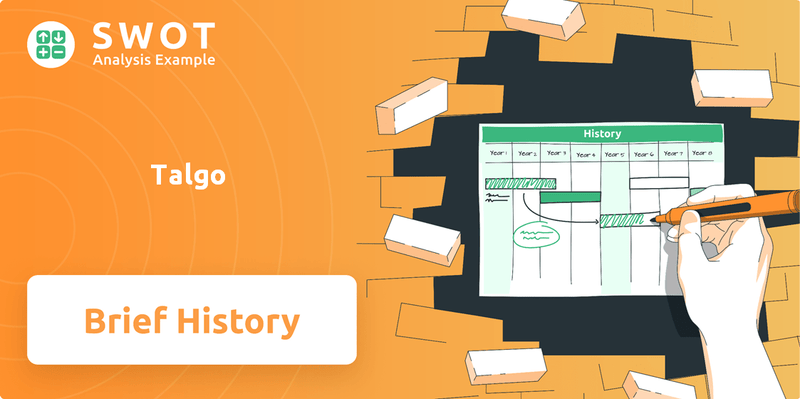
Delving into the brief history of Talgo, we uncover a story of persistent innovation in train technology. Talgo's early train models and its commitment to high-speed rail projects have solidified its position as a leader. Understanding Talgo's journey offers valuable insights into the evolution of train technology and its impact on global transportation networks.
What is the Talgo Founding Story?
The story of the Talgo company began on March 18, 1942. It was founded by the engineer Alejandro Goicoechea and José Luis de Oriol y Urquijo, who provided the financial support. Their vision was to revolutionize rail travel through innovative train designs.
The
The
The company was founded in 1942 by Alejandro Goicoechea and José Luis de Oriol y Urquijo.
- Goicoechea, an engineer, was the visionary behind the train design.
- Oriol provided the financial backing and business acumen.
- Their goal was to improve railway travel with lighter, more efficient trains.
- The Talgo I prototype demonstrated the feasibility of their design.
Talgo SWOT Analysis
- Complete SWOT Breakdown
- Fully Customizable
- Editable in Excel & Word
- Professional Formatting
- Investor-Ready Format
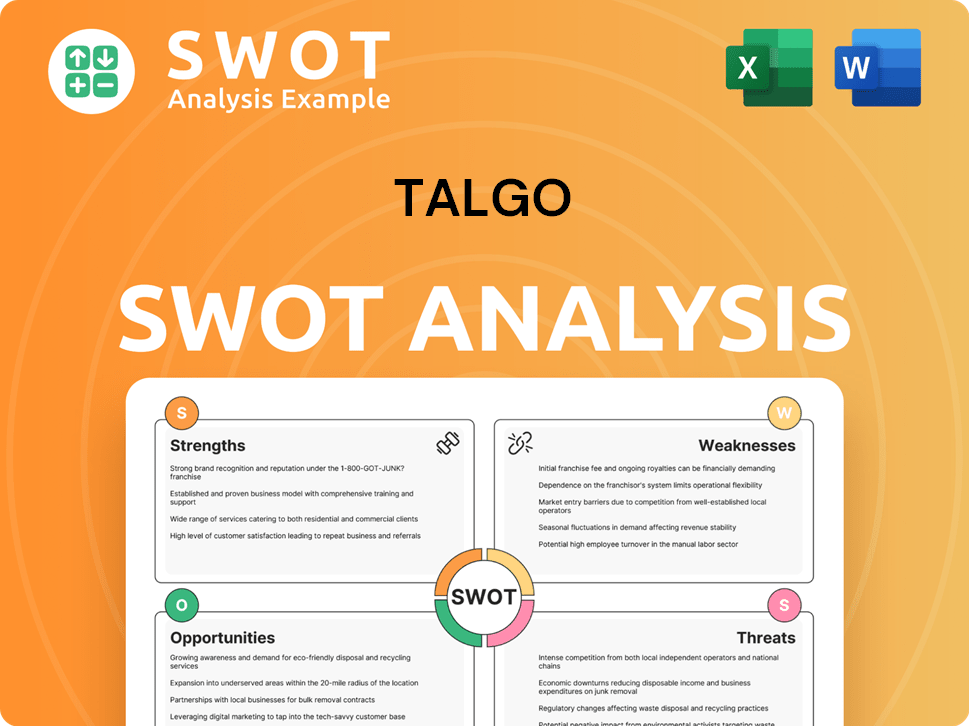
What Drove the Early Growth of Talgo?
The early growth of the Talgo company was defined by the refinement and deployment of its innovative train technology. The successful prototype led to the Talgo II entering service in the United States in 1949, showcasing the international potential of its designs. This marked an important early product launch and an initial foray into the international market. The introduction of the Talgo III in 1964 further solidified its position, becoming a staple on Spanish long-distance routes.
The Talgo II's debut in the United States in 1949 was a pivotal moment in the
The Talgo III, introduced in 1964, became a cornerstone of the Spanish railway network. Its improved speed and comfort significantly enhanced the passenger experience. This model helped establish Talgo as a leading
Initially, the primary clients for Talgo trains were national railway operators, particularly Renfe in Spain. The company established manufacturing facilities in Spain to meet the growing demand. This phase was crucial for building a solid foundation.
In the following decades, Talgo expanded its reach beyond Spain, entering European and global markets. The energy efficiency and adaptability of its trains to varying track gauges were key drivers of this expansion. This strategic shift included a focus on
Talgo PESTLE Analysis
- Covers All 6 PESTLE Categories
- No Research Needed – Save Hours of Work
- Built by Experts, Trusted by Consultants
- Instant Download, Ready to Use
- 100% Editable, Fully Customizable
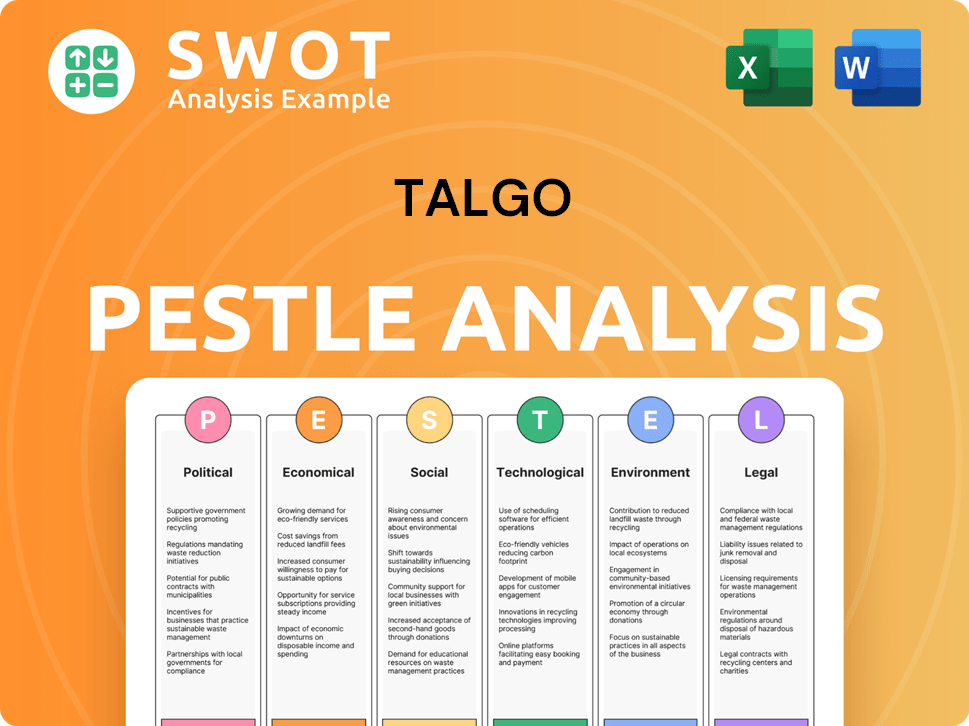
What are the key Milestones in Talgo history?
The Talgo company has a rich history marked by significant milestones, innovations, and the overcoming of various challenges. From its founding to its current projects, the company has consistently pushed the boundaries of train technology, contributing significantly to the evolution of high-speed rail and the broader rail industry.
| Year | Milestone |
|---|---|
| 1942 | The company was founded in Spain, marking the beginning of its journey as a Spanish train manufacturer. |
| 1950s | Introduction of the first Talgo train models, which revolutionized train design with their articulated carriages and independent wheel system. |
| 1980s | The Talgo Pendular, featuring a passive tilting system, was introduced, enhancing passenger comfort and increasing speed on curves. |
| 2000s | Secured major international contracts, including projects for the Haramain High-Speed Railway in Saudi Arabia and the supply of trains for Deutsche Bahn in Germany. |
| 2020s | Continued expansion and innovation, focusing on sustainable transportation solutions and advanced train technology, with ongoing projects worldwide. |
Talgo's innovations have consistently set it apart in the train technology sector. The introduction of the Talgo Pendular was a groundbreaking achievement, enabling higher speeds on curves and significantly improving passenger comfort.
Talgo pioneered articulated train designs, where carriages share a common axle, improving stability and reducing weight. This design enhances the efficiency of Talgo trains, contributing to their high-speed capabilities.
The independent wheel system allows each wheel to rotate independently, reducing friction and wear. This innovation contributes to smoother rides and enhanced energy efficiency, crucial for high-speed rail operations.
The passive tilting system allows trains to lean into curves, counteracting centrifugal force and enabling higher speeds. This system enhances passenger comfort and reduces journey times, making Talgo trains a preferred choice for high-speed rail.
Talgo trains are constructed using lightweight materials, reducing overall weight and improving energy efficiency. This design choice supports sustainable transportation by minimizing fuel consumption and emissions.
Talgo has developed variable gauge systems, allowing trains to adapt to different track widths. This innovation facilitates seamless travel across different railway networks, enhancing connectivity and reducing travel times.
Talgo trains are designed with energy efficiency in mind, incorporating features like regenerative braking and optimized aerodynamics. These features contribute to reduced energy consumption and lower environmental impact, aligning with the push for sustainable transportation.
Despite its successes, the company has faced challenges, including market downturns and intense competition. Delays in large-scale projects and the complexities of international project execution have also presented operational hurdles.
The railway industry is subject to market fluctuations, which can impact project timelines and profitability. Economic downturns and shifts in government spending on infrastructure projects can create instability for train manufacturers.
The train industry is highly competitive, with major players vying for contracts worldwide. This competition can lead to pricing pressures and the need for continuous innovation to maintain a competitive edge.
Large-scale railway projects often face delays due to various factors, including supply chain issues, regulatory hurdles, and unforeseen technical challenges. These delays can impact project costs and timelines.
Technical issues can arise during the design, manufacturing, or deployment of trains, leading to operational disruptions and the need for costly repairs. Ensuring the reliability and safety of train technology is crucial.
Securing financing for large-scale railway projects can be challenging, and financial constraints can impact project feasibility and execution. Managing cash flow and securing adequate funding are critical for success.
Complying with various safety standards and regulations across different countries can be complex and time-consuming. Navigating these regulatory requirements is essential for entering new markets and ensuring the safe operation of trains.
Talgo Business Model Canvas
- Complete 9-Block Business Model Canvas
- Effortlessly Communicate Your Business Strategy
- Investor-Ready BMC Format
- 100% Editable and Customizable
- Clear and Structured Layout
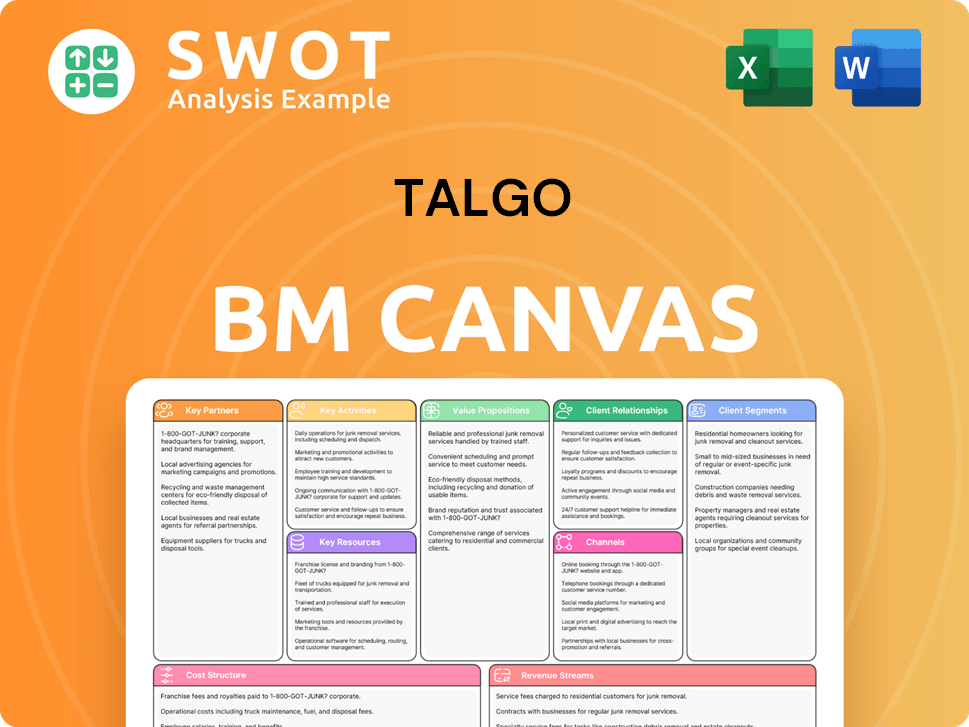
What is the Timeline of Key Events for Talgo?
The Talgo company, a prominent player in the rail industry, has a rich history marked by innovation and expansion. Founded in 1942 by Alejandro Goicoechea and José Luis de Oriol y Urquijo, the company initially focused on revolutionizing train design. Over the years, Talgo has introduced numerous advancements, from early models to high-speed trains, establishing itself as a key player in train technology. Its evolution reflects a commitment to enhancing speed, comfort, and efficiency in rail travel, driving its global presence and impact on modern transportation.
| Year | Key Event |
|---|---|
| 1942 | The Talgo company was founded by Alejandro Goicoechea and José Luis de Oriol y Urquijo. |
| 1949 | Talgo II entered service in the United States, marking an early international presence. |
| 1964 | Talgo III was introduced in Spain, significantly enhancing speed and passenger comfort. |
| 1980s | The company introduced the Talgo Pendular passive tilting system, an innovative design feature. |
| 1992 | Talgo 200 high-speed trains began operating on the Madrid-Seville line. |
| 2000s | Expansion into international markets, including Germany and Kazakhstan, occurred. |
| 2011 | A contract was awarded for high-speed trains for the Haramain High-Speed Railway in Saudi Arabia. |
| 2015 | Talgo went public, listing on the Madrid Stock Exchange. |
| 2019 | The acquisition of Talgo Oy (formerly Transtech Oy) expanded manufacturing capabilities. |
| 2024 | Talgo continues to pursue new projects globally, with a focus on sustainable and high-speed rail solutions. |
Talgo is actively investing in research and development (R&D) for next-generation high-speed trains. This includes focusing on enhanced energy efficiency, reduced environmental impact, and increased digitalization of railway systems. These initiatives align with global trends towards sustainable transportation and advanced train technology.
The company aims to capitalize on the growing global demand for sustainable and efficient public transportation. With its order book exceeding €4 billion as of early 2024, Talgo demonstrates robust future prospects. The push for decarbonization and increased investment in high-speed rail networks worldwide are expected to positively influence its future.
Talgo's future outlook is tied to its founding vision of revolutionizing rail transport through innovative engineering. The company is committed to delivering advanced and efficient railway solutions worldwide. Leadership emphasizes innovation and expanding its global footprint, particularly in markets prioritizing advanced railway technology.
Industry trends, such as the push for decarbonization and increased investment in high-speed rail networks worldwide, are likely to positively impact Talgo's future. The company's focus on sustainable transportation solutions positions it well to meet the evolving needs of the global market. This includes continued innovation in Talgo trains.
Talgo Porter's Five Forces Analysis
- Covers All 5 Competitive Forces in Detail
- Structured for Consultants, Students, and Founders
- 100% Editable in Microsoft Word & Excel
- Instant Digital Download – Use Immediately
- Compatible with Mac & PC – Fully Unlocked
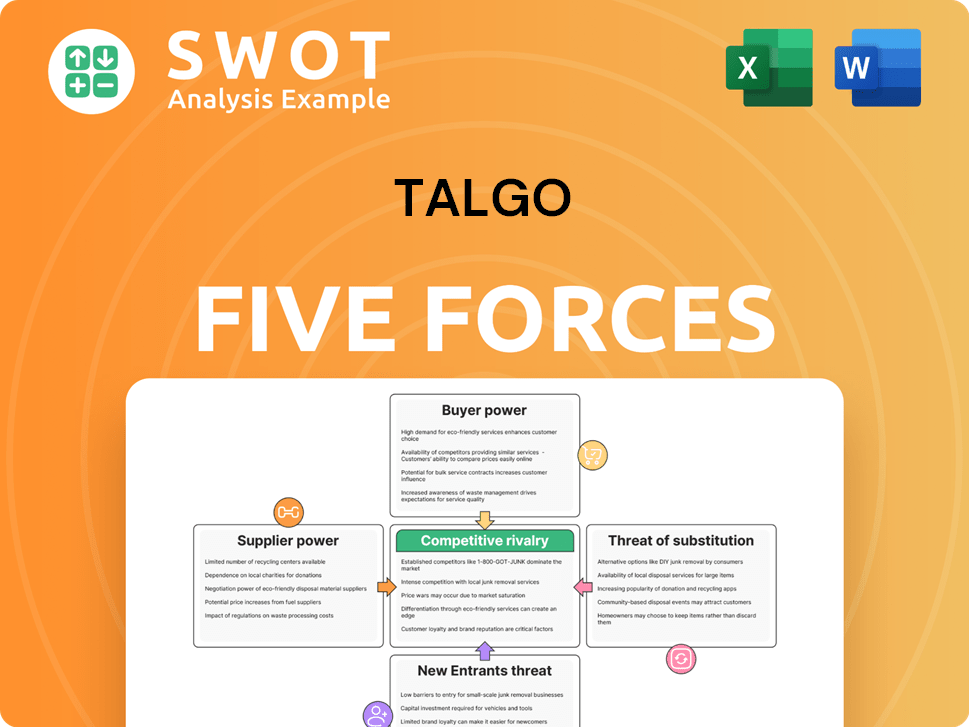
Related Blogs
- What is Competitive Landscape of Talgo Company?
- What is Growth Strategy and Future Prospects of Talgo Company?
- How Does Talgo Company Work?
- What is Sales and Marketing Strategy of Talgo Company?
- What is Brief History of Talgo Company?
- Who Owns Talgo Company?
- What is Customer Demographics and Target Market of Talgo Company?
Disclaimer
All information, articles, and product details provided on this website are for general informational and educational purposes only. We do not claim any ownership over, nor do we intend to infringe upon, any trademarks, copyrights, logos, brand names, or other intellectual property mentioned or depicted on this site. Such intellectual property remains the property of its respective owners, and any references here are made solely for identification or informational purposes, without implying any affiliation, endorsement, or partnership.
We make no representations or warranties, express or implied, regarding the accuracy, completeness, or suitability of any content or products presented. Nothing on this website should be construed as legal, tax, investment, financial, medical, or other professional advice. In addition, no part of this site—including articles or product references—constitutes a solicitation, recommendation, endorsement, advertisement, or offer to buy or sell any securities, franchises, or other financial instruments, particularly in jurisdictions where such activity would be unlawful.
All content is of a general nature and may not address the specific circumstances of any individual or entity. It is not a substitute for professional advice or services. Any actions you take based on the information provided here are strictly at your own risk. You accept full responsibility for any decisions or outcomes arising from your use of this website and agree to release us from any liability in connection with your use of, or reliance upon, the content or products found herein.